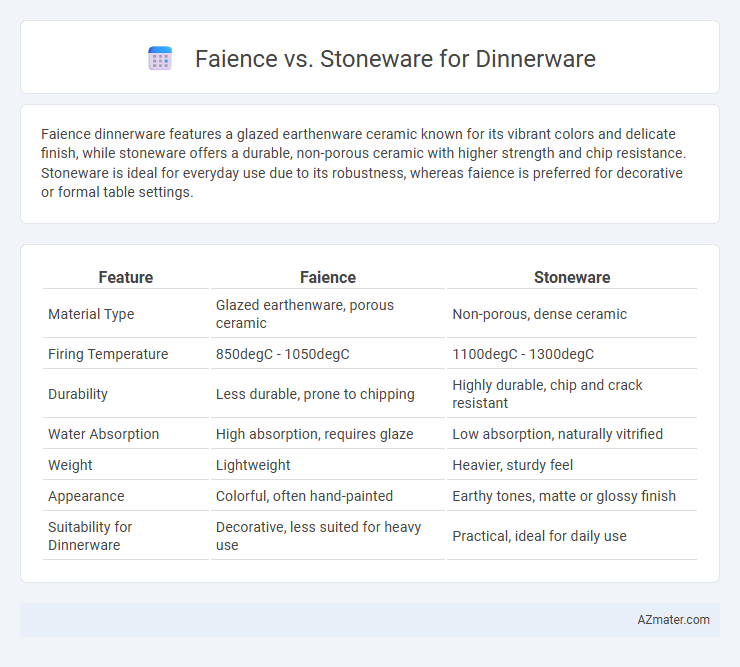Faience dinnerware features a glazed earthenware ceramic known for its vibrant colors and delicate finish, while stoneware offers a durable, non-porous ceramic with higher strength and chip resistance. Stoneware is ideal for everyday use due to its robustness, whereas faience is preferred for decorative or formal table settings.
Table of Comparison
| Feature | Faience | Stoneware |
|---|---|---|
| Material Type | Glazed earthenware, porous ceramic | Non-porous, dense ceramic |
| Firing Temperature | 850degC - 1050degC | 1100degC - 1300degC |
| Durability | Less durable, prone to chipping | Highly durable, chip and crack resistant |
| Water Absorption | High absorption, requires glaze | Low absorption, naturally vitrified |
| Weight | Lightweight | Heavier, sturdy feel |
| Appearance | Colorful, often hand-painted | Earthy tones, matte or glossy finish |
| Suitability for Dinnerware | Decorative, less suited for heavy use | Practical, ideal for daily use |
Introduction to Faience and Stoneware
Faience is a type of tin-glazed pottery known for its bright, opaque surface and intricate painted designs, often associated with historic European ceramics such as Italian majolica and French faience. Stoneware is a durable, non-porous ceramic fired at high temperatures, typically between 1200degC and 1300degC, which gives it strength and resistance to chipping, making it ideal for everyday dinnerware. Both faience and stoneware serve functional and decorative purposes, with faience prized for its artistic appeal and stoneware favored for its robustness and practicality in daily use.
Historical Origins and Development
Faience, originating in ancient Egypt and later flourishing in the Mediterranean during the Renaissance, is a tin-glazed earthenware known for its bright, opaque surface and decorative artistry. Stoneware, with roots tracing back to Chinese ceramics around 1600 BCE and prominent in Europe by the 16th century, is characterized by its dense, vitrified body and durability suited for functional dinnerware. The development of faience emphasized ornamental aesthetics and colorful glazes, whereas stoneware evolved to prioritize strength and practicality in everyday use.
Key Material Differences
Faience dinnerware is made from tin-glazed earthenware, characterized by its porous, less vitrified body and vibrant, opaque surface finished with a glossy glaze that enhances decorative patterns. Stoneware, in contrast, is crafted from dense, non-porous clay fired at higher temperatures, resulting in a durable, vitrified body with a natural, often matte or semi-gloss finish that resists chipping and water absorption. The key material difference lies in faience's tin glaze and porous earthenware base versus stoneware's dense, vitrified clay structure offering superior strength and durability.
Manufacturing Processes Compared
Faience dinnerware is crafted using tin-glazed earthenware techniques, involving a porous clay base coated with a white opaque glaze fired at lower temperatures around 950degC-1050degC. Stoneware undergoes high-temperature firing between 1200degC and 1300degC, resulting in a dense, vitrified, and non-porous structure that enhances durability and chip resistance. The faience manufacturing process allows for intricate painted decoration under the glaze, whereas stoneware emphasizes robustness and minimal water absorption due to its vitrification.
Durability and Strength
Faience dinnerware, made from glazed earthenware, is more porous and less dense compared to stoneware, resulting in lower durability and a higher risk of chipping or cracking. Stoneware, fired at higher temperatures, boasts superior strength, resistance to chipping, and better suitability for everyday use and heavy handling. Choosing stoneware ensures long-lasting dinnerware that withstands regular use and dishwasher cleaning without significant wear.
Aesthetic Appeal and Glaze Options
Faience dinnerware offers vibrant, hand-painted designs with a glossy, translucent glaze that enhances intricate patterns and bright colors, creating a traditional Mediterranean aesthetic. Stoneware provides a more rustic, matte or satin finish with earthy tones, supporting thicker, durable glazes that emphasize natural textures and handcrafted appeal. The choice between faience and stoneware dinnerware depends on preference for decorative vibrancy versus understated elegance and glaze durability.
Practical Functionality in Daily Use
Faience dinnerware offers a lightweight, decorative option ideal for casual dining but may chip easily and lacks the durability of stoneware. Stoneware provides superior strength and resistance to thermal shock, making it practical for everyday use and suitable for microwave and dishwasher safety. Its dense, non-porous surface resists stains and scratches, ensuring long-lasting performance in busy kitchens.
Maintenance and Care Requirements
Faience dinnerware requires gentle hand washing and careful handling to prevent chipping and loss of glaze due to its porous and delicate nature. Stoneware is more durable and resistant to chips and scratches, making it dishwasher-safe and suitable for higher temperatures in microwaves and ovens. Regular sealing of faience is recommended to maintain its finish, whereas stoneware demands minimal maintenance for long-lasting use.
Cost Comparison and Value
Faience dinnerware typically offers a lower upfront cost compared to stoneware, making it an attractive option for budget-conscious consumers. Stoneware, however, provides greater durability and chip resistance, which can translate to long-term value despite higher initial expenses. When evaluating cost versus value, stoneware's sturdiness often results in fewer replacements over time, offering better investment for frequent use.
Which Is Best for Your Table?
Faience offers a delicate, glossy finish with intricate hand-painted designs, making it ideal for decorative or formal dining settings, but it is more porous and less durable than stoneware. Stoneware provides robust durability, chip resistance, and a naturally earthy aesthetic, suitable for everyday use and families seeking long-lasting dinnerware. Choosing between faience and stoneware depends on your priorities for elegance versus practicality and how often your dinnerware will endure heavy use.

Infographic: Faience vs Stoneware for Dinnerware
 azmater.com
azmater.com